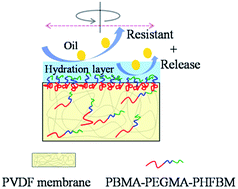Improved antifouling property of PVDF membranes by incorporating an amphiphilic block-like copolymer for oil/water emulsion separation
Abstract
An amphiphilic block-like copolymer bearing hydrophobic poly(butyl methacrylate) (PBMA), hydrophilic poly(poly(ethylene glycol) methyl ether methacrylate) (PEGMA) and low surface energy poly(hexafluorobutyl methacrylate) (PHFBM) segments was synthesized by free radical polymerization. The copolymer was then used as an additive to fabricate antifouling polyvinylidene difluoride (PVDF) membranes by the non-solvent induced phase separation (NIPS) method. During the membrane preparation process, the low surface energy PHFBM segments were dragged to the membrane surfaces by the surface segregated hydrophilic PEGMA segments. The presence of the PHFBM segments on the membrane surfaces significantly enhanced the antifouling property of the PVDF membranes during oil/water emulsion filtration. The total flux decline (Rt) was drastically decreased to 10.6% and the flux recovery ratio (FRR) was 99.4%. In addition, the influences of different operating conditions (including agitating speed, operating pressure and oil concentration) on the antifouling property were extensively investigated. The fluxes were nearly completely recovered after simple hydraulic cleaning even under a low agitating speed, high operating pressure and high oil concentration.


 Please wait while we load your content...
Please wait while we load your content...